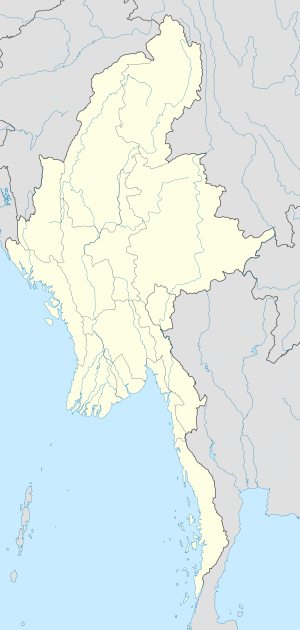Mingun Pahtodawgyi
The Mingun Pahtodawgyi (မင်းကွန်းပုထိုးတော်ကြီး, IPA: [mɪ́ɴɡʊ́ɴ patʰóu dɔ̀ dʑí]) is an incomplete monument stupa in Mingun, approximately 10 kilometres (6.2 mi) northwest of Mandalay in Sagaing Region in central Myanmar (formerly Burma). The ruins are the remains of a massive construction project begun by King Bodawpaya in 1790 which was intentionally left unfinished. The pahtodawgyi is seen as the physical manifestations of the well known eccentricities of Bodawpaya. He set up an observation post on an island off Mingun to personally supervise the construction of the temple.
| Mingun Pahtodawgyi မင်းကွန်းပုထိုးတော်ကြီး | |
|---|---|
Mingun Pahtodawgyi from the southeast | |
| Religion | |
| Affiliation | Theravada Buddhism |
| Location | |
| Location | Mingun, Sagaing Region |
| Country | Myanmar |
 Shown within Myanmar | |
| Geographic coordinates | 22°03′03″N 96°01′3″E |
| Architecture | |
| Founder | King Bodawpaya |
| Completed | 1790 |
Incompletion

Bodawpaya used thousands of prisoners of war from his expansionist campaigns and slaves working on the construction of the stupa. The construction was also seen as having a heavy toll over the people and the state, thus a prophecy was allegedly created, to stop the project. The approach in conveying the dissatisfaction was allegedly to utilize the King's deep superstition. The prophecy went "as soon as the building of the pagoda was over, the country would also be gone".[1]
A variation states that king would die once the project was completed. Thus, construction was slowed to prevent the prophecy's realisation and when the king died, the project was completely halted.
A model pagoda nearby (known as the Pon Daw Pagoda), typical of many large pagoda projects like the Shwedagon Pagoda and Thatbyinnyu Temple, offers a small scale of what would have been a 150 metres (490 ft) tall temple.
However, it holds the record of being the largest pile of bricks in the world.
Current condition
By the time the construction project was abandoned, the pagoda had attained a height of 50 metres, one third of the intended height. An earthquake on 23 March 1839 caused huge cracks to appear on the face of the remaining structure.[2] The temple serves more as an attraction than a religious site. However, a small shrine with a Buddha image still serves its purpose as a place of worship and meditation.[3] Pondaw paya or a working model of the stupa can be seen nearby.
Mingun Bell
King Bodawpaya also had a gigantic bell cast to go with his huge stupa. The Mingun Bell, weighing at 90 tons, is today the second largest ringing bell in the world. The weight of the bell in Burmese measurement, is 55,555 viss or peiktha (1 viss = 1.63 kg), handed down as a mnemonic "Min Hpyu Hman Hman Pyaw", with the consonants representing the number 5 in Burmese astronomy and numerology. [4][5]
Accessibility
Mingun can be reached by a ferry across the Irrawaddy river from Mandalay and then optionally by foot or by bullock cart from the river jetty.
 Nun on alms round, Mingun Paya, Myanmar Courtesy: http://www.whileseated.org
Nun on alms round, Mingun Paya, Myanmar Courtesy: http://www.whileseated.org- River Irrawaddy at Mingun
 Looking westward from the Irrawaddy River
Looking westward from the Irrawaddy River- Mingun pagoda
- Mingun Bell
 Remains of giant Chinthe
Remains of giant Chinthe- There is a path to reach the top of the pagoda
- There is a small shrine with a Buddha inside the east portal of Mingun Pahtodawgyi
- Climbing to the top of Mingun Pahtodawgyi, a small platform for a great view of the Irrawaddy River
References
- http://myanmartravel.org/mandalay/mingun.html
- Burma:Preservation and restoration of national monuments and artifacts at selected sites, pages 5 and 9, UNESCO, Paris, 1984.
- "Mingun". Myanmar's Net Inc. Retrieved 2007-03-15.
- "The World's Three Largest Bells". Blagovest Bells. Retrieved 2007-03-15.
- "The Mingun Bell". Myanmar's Net Inc. Archived from the original on 2012-09-09. Retrieved 2007-03-15.